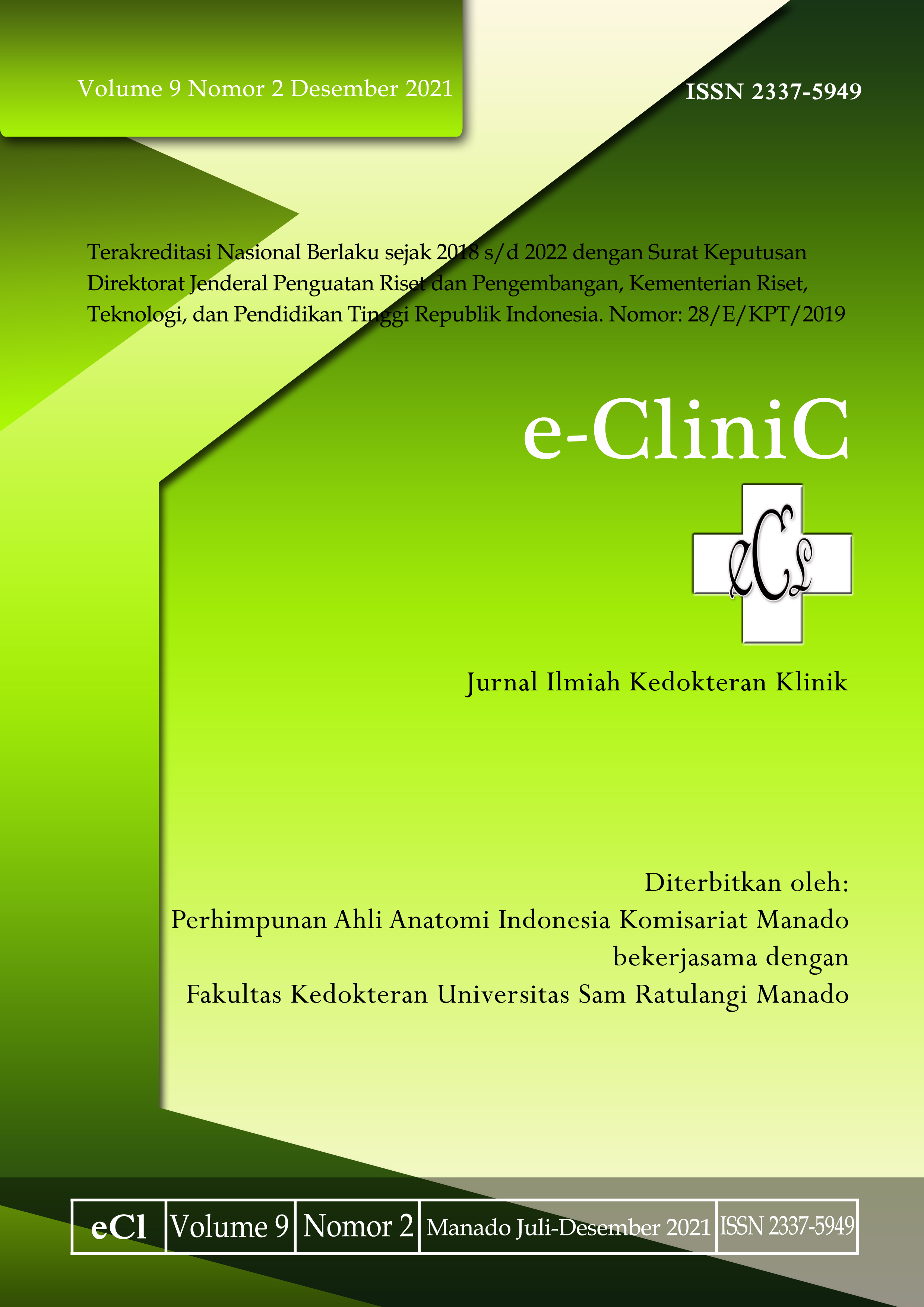Akurasi Gambaran CT Scan Tulang Temporal Preoperatif dalam Menilai Kolesteatoma pada Penderita Otitis Media Supuratif Kronis (OMSK)
DOI:
https://doi.org/10.35790/ecl.v9i2.32437Abstract
Abstract: This study was aimed to determine the accuracy of preoperative temporal bone CT-scan ini assessing cholesteatoma in chronic suppurative otitis media (CSOM) patients. This was a diagnostic test study conducted by comparing the findings of the preoperative temporal bone CT-scan with the intraoperative findings of 54 CSOM patients who had a temporal bone CT-scan followed by surgery at the Hasanuddin University Hospital and the Jaury Academic Hospital. Assessment of cholesteatoma on a preoperative temporal bone CT-scan was performed when soft tissue density was found in the middle ear accompanied by bone erosion. In addition, an assessment was also carried out for the presence of ossicular, scutum, tympanic tegmen, facial nerve canal and mastoid tegmen erosions. The results indicated that the accuracy of preoperative temporal bone CT-scan in assessing cholesteatoma in CSOM patients was 87.04% with a sensitivity of 85%, specificity of 88.23%, a positive predictive value of 80.95%, and a negative predictive value of 90.91%. The sensitivity of the preoperative temporal bone CT-scan in assessing the highest erosion of cholesteatoma in the erosion of the scutum and tympanic tegmen (100%) with the specificity and accuracy of the preoperative temporal bone CT scan of the in assessing erosions in cholesteatoma highest on mastoid tegman erosion  (100% and 96.29%). In conclusion, preoperative CT scan of temporal bone has high accuracy, sensitivity, and specifity values in assessing cholesteatoma and erosions of surrounding structures.
Keywords: cholesteatoma, chronic suppurative otitis media (CSOM), temporal bone CT-Scan
Â
 Abstrak: Penelitian ini bertujuan untuk mengetahui akurasi gambaran CT-scan tulang temporal preoperatif dalam menilai kolesteatoma pada penderita otitis media supuratif kronis (OMSK). Jenis penelitian ialah uji diagnostik yang membandingkan temuan pada CT scan tulang temporal preoperatif dengan hasil temuan intraoperatif pada 54 penderita OMSK yang menjalani pemeriksaan CT scan tulang temporal dilanjutkan dengan tindakan operasi di Rumah Sakit Universitas Hasanuddin dan Rumah Sakit Akademis Jaury. Penilaian kolesteatoma pada CT Scan tulang temporal preoperatif ketika ditemukan densitas jaringan lunak di telinga tengah yang disertai dengan erosi tulang. Selain itu, dilakukan penilaian adanya erosi osikula, skutum, tegmen timpani, kanalis nervus fasialis, dan tegmen mastoid. Hasil penelitian mendapatkan akurasi CT scan tulang temporal preoperatif dalam menilai kolesteatoma pada penderita OMSK sebesar 87,04% dengan sensitivitas 85%, spesifisitas 88,23%, nilai prediksi positif 80,95%, dan nilai prediksi negatif 90,91%. Sensitivitas CT scan tulang temporal preoperatif dalam menilai erosi pada kolesteatoma tertinggi pada erosi skutum dan tegmen timpani (100%) dengan spesifisitas dan akurasi CT scan tulang temporal preoperatif dalam menilai erosi pada kolesteatoma tertinggi pada erosi tegmen mastoid (100% dan 96.29%). Simpulan penelitian ini ialah CT scan tulang temporal preoperatif memiliki nilai akurasi, sensitivitas, serta spesifisitas yang cukup tinggi dalam menilai kolesteatoma serta erosi pada struktur di sekitarnya.
Kata kunci: kolesteatoma, otitis media supuratif kronis (OMSK), CT scan tulang temporal
Downloads
Additional Files
Published
How to Cite
Issue
Section
License
COPYRIGHT
Authors who publish with this journal agree to the following terms:
Authors hold their copyright and grant this journal the privilege of first publication, with the work simultaneously licensed under a Creative Commons Attribution License that permits others to impart the work with an acknowledgment of the work's origin and initial publication by this journal.
Authors can enter into separate or additional contractual arrangements for the non-exclusive distribution of the journal's published version of the work (for example, post it to an institutional repository or publish it in a book), with an acknowledgment of its underlying publication in this journal.
Authors are permitted and encouraged to post their work online (for example, in institutional repositories or on their website) as it can lead to productive exchanges, as well as earlier and greater citation of the published work (See The Effect of Open Access).







